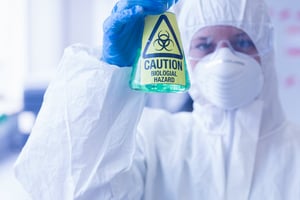Share this
workplace safety and occupational exposure testing
by Neoteryx Microsampling on Nov 23, 2020 9:00:00 AM
 What is occupational exposure? Millions of people are exposed to chemicals, environmental toxins, or other hazardous materials in their workplace every day. If not handled safely, these hazards can cause health problems that range from mild irritations, allergies and illnesses to severe neurological damage, cancer, and even death.
What is occupational exposure? Millions of people are exposed to chemicals, environmental toxins, or other hazardous materials in their workplace every day. If not handled safely, these hazards can cause health problems that range from mild irritations, allergies and illnesses to severe neurological damage, cancer, and even death.
All employees have the right to safe and healthy working conditions, yet many jobs have inherent occupational exposures, which may require biomonitoring and occupational exposure testing. To protect workers from hazardous exposures, employers in many countries must follow the safety guidelines of the Occupational Safety and Health Administration (OSHA), or a similar workplace safety organization. Such guidelines and safety protocols are enforced to protect workers from toxins, hazards and injury. In some regions, employers must also provide occupational toxicology or hazardous chemical exposure testing.
Which toxins and industries pose the greatest risk for occupational exposure?
 The types of workplace materials or chemicals that pose risks with exposure include carcinogens (causing cancer), corrosives (causing visible injury and destruction), irritants (causing inflammation), mutagens (damaging chromosomes), sensitizers (causing allergic reactions), and teratogens (causing birth defects).
The types of workplace materials or chemicals that pose risks with exposure include carcinogens (causing cancer), corrosives (causing visible injury and destruction), irritants (causing inflammation), mutagens (damaging chromosomes), sensitizers (causing allergic reactions), and teratogens (causing birth defects).
Here are the industries that pose the greatest potential danger for chemical exposure in the workplace or other types of occupational exposure:
- Chemical industry (chemical laboratories, etc.)
- Electronics industry (fluorescent lights, neon, etc.)
- Manufacturing (batteries, thermometers, paper/pulp, glass, radiography machines, etc.)
- Construction, shipyards & marine terminals, salvage companies
- Mining (gold mining, etc.)
- Healthcare (blood-borne diseases: HIV/AIDS, Hepatitis, etc.)
- Farming industry (pesticides, etc.)
What are the most common hazards and chemical exposures in the workplace?
 Some workplace exposures result in immediate injuries, such as chemical burns. Other exposures, such as exposure to heavy metals, can take a toll on a person’s health over time. If even relatively minor exposure is repeated over several years of employment, it can lead to life-changing medical conditions years later. Here are the most common hazardous materials and chemical exposures linked to health problems:
Some workplace exposures result in immediate injuries, such as chemical burns. Other exposures, such as exposure to heavy metals, can take a toll on a person’s health over time. If even relatively minor exposure is repeated over several years of employment, it can lead to life-changing medical conditions years later. Here are the most common hazardous materials and chemical exposures linked to health problems:
- Aluminum
- Asbestos
- Benzene
- Lead
- Mercury
- Cadmium
- Petroleum
- Pesticides
- Silica
- Acids
- Bio-fluids, bio-hazards (i.e., infectious blood, mucus, specimens, etc. )
How do workplace toxins enter the body?
Here are the most common ways that chemicals and other dangerous elements come into contact with workers, leading to potential biological effects:
- Inhalation (breathing gases, vapors, mists, dust, fumes, smoke)
- Skin contact (liquid chemicals can be absorbed through skin)
- Eye contact (splashing into eyes or rubbing in/near eyes)
- Ingestion (swallowing or eating)
- Injection (skin punctures)
 The most common route of entry is via breathing contaminated air. Some workplace chemicals enter the body via direct contact—they can pass through the skin and, from there, into the blood stream. The Centers for Disease Control and Prevention (CDC) estimate that more than 12 million workers in the United States alone are potentially exposed to chemicals or other toxins that can be absorbed through the skin. While only small quantities of chemicals in the workplace enter the body through the eyes, this is another potential point of entry.
The most common route of entry is via breathing contaminated air. Some workplace chemicals enter the body via direct contact—they can pass through the skin and, from there, into the blood stream. The Centers for Disease Control and Prevention (CDC) estimate that more than 12 million workers in the United States alone are potentially exposed to chemicals or other toxins that can be absorbed through the skin. While only small quantities of chemicals in the workplace enter the body through the eyes, this is another potential point of entry.
It is important not to eat, drink or smoke in contaminated areas or to store food in such areas at the workplace, as harmful chemicals and other substances may be swallowed accidentally. This can occur if hands, food or cigarettes have been contaminated.
Injection via a skin puncture is a point of entry for harmful chemicals, viruses and other bio-contaminants. This route is a hazard primarily for healthcare workers who handle needles in hospital or lab settings, or others who handle sharp objects in industrial hole-punching or injection processes. With skin punctures, a hazardous material can enter the bloodstream directly.
Regardless of the way a chemical or other hazardous material enters the body, once it gets in, it can pass into the bloodstream, which distributes it throughout a person’s system. In this way, the toxin has the potential to harm organs—even those that are far away from the initial route or point of entry.
While prevention is the best way to protect workers from potential exposure, early detection and diagnosis through routine exposure testing can identify problems and the need for medical interventions.
How is occupational exposure testing conducted?
Many toxic substances and exposures can be detected in urine, blood, and even hair. For this reason, occupational testing may begin with the collection of a urine, blood or hair sample for lab analysis. The type of sample typically depends upon the type of exposure. In some cases, ultrasound and other diagnostic methods may also be used for more comprehensive testing of work-related exposures that are linked to illnesses (i.e., liver disease).
 In the workplace setting, the first step in baseline screening of employees for many occupational exposures can be performed onsite with fingerstick blood collection devices. No special training is required with some of these portable alternatives to traditional blood draws. For example, the Mitra® microsampling device is ideal for simple, onsite collection of blood samples.
In the workplace setting, the first step in baseline screening of employees for many occupational exposures can be performed onsite with fingerstick blood collection devices. No special training is required with some of these portable alternatives to traditional blood draws. For example, the Mitra® microsampling device is ideal for simple, onsite collection of blood samples.
Based on volumetric absorptive microsampling (VAMS®), the Mitra device absorbs a small volume of blood (1-3 drops) from a fingertip that has been pricked with a lancet. Once collected, the blood "microsample" is enclosed in the Mitra device’s protective case, which is sealed in a foil specimen bag, placed inside a special envelope, and mailed to the lab for processing and analysis. Employers can coordinate with their designated lab to retrieve employee's test results privately via a secure computer system or other communication channel.
To find a lab with expertise in analyzing remote specimen samples:

Sources:
https://www.cdc.gov/niosh/docs/2024-101/
https://www.ncbi.nlm.nih.gov/pmc/articles/PMC5877048/
https://www.ccohs.ca/oshanswers/chemicals/how_chem.html
https://www.osha.gov/SLTC/hazardoustoxicsubstances/
https://emedicine.medscape.com/article/1175560-overview#a4
https://www.medscape.com/viewarticle/922497
https://emedicine.medscape.com/article/814960-overview
https://emedicine.medscape.com/article/297248-overview
https://nccc.ucsf.edu/clinical-resources/pep-resources/pep-quick-guide-for-occupational-exposures/
Share this
- Microsampling (206)
- Research, Remote Research (119)
- Venipuncture Alternative (105)
- Clinical Trials, Clinical Research (83)
- Mitra® Device (73)
- Therapeutic Drug Monitoring, TDM (51)
- Dried Blood Spot, DBS (39)
- Biomonitoring, Health, Wellness (30)
- Infectious Disease, Vaccines, COVID-19 (24)
- Blood Microsampling, Serology (23)
- Omics, Multi-Omics (21)
- Decentralized Clinical Trial (DCT) (20)
- Specimen Collection (18)
- Toxicology, Doping, Drug/Alcohol Monitoring, PEth (17)
- Skin Microsampling, Microbiopsy (14)
- hemaPEN® Device (13)
- Preclinical Research, Animal Studies (12)
- Pharmaceuticals, Drug Development (9)
- Harpera Device (7)
- Industry News, Microsampling News (5)
- Antibodies, MAbs (3)
- Company Press Release, Product Press Release (3)
- Environmental Toxins, Exposures (1)
- July 2025 (1)
- May 2025 (1)
- April 2025 (2)
- December 2024 (2)
- November 2024 (1)
- October 2024 (3)
- September 2024 (1)
- June 2024 (1)
- May 2024 (1)
- April 2024 (4)
- March 2024 (1)
- February 2024 (2)
- January 2024 (4)
- December 2023 (3)
- November 2023 (3)
- October 2023 (3)
- September 2023 (3)
- July 2023 (3)
- June 2023 (2)
- April 2023 (2)
- March 2023 (2)
- February 2023 (2)
- January 2023 (3)
- December 2022 (2)
- November 2022 (3)
- October 2022 (4)
- September 2022 (3)
- August 2022 (5)
- July 2022 (2)
- June 2022 (2)
- May 2022 (4)
- April 2022 (3)
- March 2022 (3)
- February 2022 (4)
- January 2022 (5)
- December 2021 (3)
- November 2021 (5)
- October 2021 (3)
- September 2021 (3)
- August 2021 (4)
- July 2021 (4)
- June 2021 (4)
- May 2021 (4)
- April 2021 (3)
- March 2021 (5)
- February 2021 (4)
- January 2021 (4)
- December 2020 (3)
- November 2020 (5)
- October 2020 (4)
- September 2020 (3)
- August 2020 (3)
- July 2020 (6)
- June 2020 (4)
- May 2020 (4)
- April 2020 (3)
- March 2020 (6)
- February 2020 (3)
- January 2020 (4)
- December 2019 (5)
- November 2019 (4)
- October 2019 (2)
- September 2019 (4)
- August 2019 (4)
- July 2019 (3)
- June 2019 (7)
- May 2019 (6)
- April 2019 (5)
- March 2019 (6)
- February 2019 (5)
- January 2019 (8)
- December 2018 (3)
- November 2018 (4)
- October 2018 (7)
- September 2018 (6)
- August 2018 (5)
- July 2018 (8)
- June 2018 (6)
- May 2018 (5)
- April 2018 (6)
- March 2018 (4)
- February 2018 (6)
- January 2018 (4)
- December 2017 (2)
- November 2017 (3)
- October 2017 (2)
- September 2017 (4)
- August 2017 (2)
- July 2017 (4)
- June 2017 (5)
- May 2017 (6)
- April 2017 (6)
- March 2017 (5)
- February 2017 (4)
- January 2017 (1)
- July 2016 (3)
- May 2016 (1)
- April 2016 (2)


Comments (3)